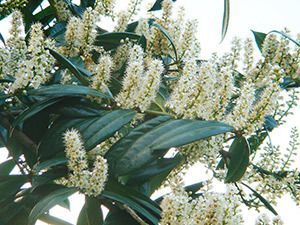Cherry Laurel

Prunus caroliniana
Family: Rosaceae (Rose Family)
Cherry Laurel (Prunus caroliniana), also known as Carolina Laurel Cherry or Laurel Cherry, is an evergreen native tree or large shrub found throughout the southeastern United States, including Southeast Texas. It is valued for its dense foliage, fragrant flowers, and usefulness as a screen or ornamental plant. While attractive and adaptable, this species should be used with care due to its potential invasiveness and toxicity.
- Scientific Name: Prunus caroliniana
- Common Names: Cherry Laurel, Carolina Laurel Cherry, Laurel Cherry
- Family: Rosaceae (Rose Family)
- Growth Habit: Evergreen tree or large shrub
- Height: 15-40 feet
- Leaves: Glossy, dark green, leathery, with a slight scent of almonds when crushed
- Flowers: Small, white, fragrant flowers in clusters
- Fruit: Small black cherries, attractive to birds
- Bloom Time: Late winter to early spring
- Wildlife Benefits: Berries feed birds and small mammals; dense cover provides shelter
Habitat & Range in Southeast Texas
Cherry Laurel grows well in a variety of conditions:
- Woodlands & Forest Edges: Prefers well-drained soils
- Urban & Suburban Landscapes: Commonly planted as a hedge, screen, or small shade tree
- Disturbed Areas: Can naturalize and spread aggressively in some areas
It tolerates a range of soil types and is drought-tolerant once established.
Ecological Importance
- Wildlife Value: Fruits are eaten by birds, and the evergreen foliage provides year-round shelter
- Erosion Control: Dense root systems can help stabilize soils in urban and suburban landscapes
- Cautionary Note: Leaves and seeds contain cyanogenic compounds that are toxic to pets and livestock if ingested
Landscaping & Gardening Uses
Cherry Laurel is often used in landscape design for its year-round greenery and rapid growth:
- Privacy Screens & Hedges: Dense, fast-growing foliage creates an excellent barrier
- Ornamental Planting: Fragrant blooms and glossy leaves provide aesthetic appeal
- Urban Planting: Tolerates pollution, drought, and various soil types
Planting & Care
- Sunlight: Full sun to partial shade
- Soil: Adaptable; prefers well-drained soils
- Water Needs: Moderate; drought-tolerant once established
- Maintenance: Low; can be pruned to maintain shape and size
- Companion Plants: Works well with Yaupon Holly (Ilex vomitoria), Wax Myrtle (Morella cerifera), and Southern Waxleaf Ligustrum (Ligustrum japonicum)
Fun Facts
- Crushed leaves smell like almonds due to the presence of cyanogenic glycosides.
- Despite the name, the fruit is not edible for humans and should be avoided.
- Cherry Laurel is native but can behave aggressively and outcompete other native understory plants.
Conservation & Native Plant Advocacy
While Cherry Laurel is native and has valuable uses, gardeners and land managers should monitor its spread and consider alternatives in sensitive natural areas to preserve plant diversity.
Where to Find It
-
Interested in adding Cherry Laurel to your garden? Check if this is in stock or add to cart to purchase directly from our Natives Nursery.


